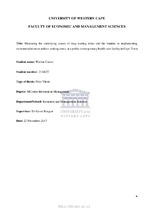| dc.contributor.advisor | Reagon, Gavin | |
| dc.contributor.author | Caesar, Warren | |
| dc.date.accessioned | 2019-02-04T13:40:56Z | |
| dc.date.available | 2019-02-04T13:40:56Z | |
| dc.date.issued | 2017 | |
| dc.identifier.uri | http://hdl.handle.net/11394/6541 | |
| dc.description | Magister Commercii (Information Management) - MCom(IM) | en_US |
| dc.description.abstract | Long waiting times before receiving a health service, give rise to long queues and congested health
facilities, both of which are unnecessary and avoidable. Since patients in part judge the quality of the
service by the length of time they spent waiting for it, it is imperative to measure waiting times, and
determine and mitigate the immediate and underlying causes of lengthy waits. The facility under
investigation was known to have excessively long waiting times. Since the immediate causes of long
waiting times were known, it was thus required to research and understand the underlying causes of
long waiting times and consequently whether there were any barriers to implementing
recommendations to reduce waiting times at this primary health care facility.
AIM: The aim of the study was to determine the underlying causes of long waiting times and the
barriers to implementing recommendations to reduce waiting times.
METHODS: A quantitative cross-sectional analytical study with a small qualitative component was
undertaken. The qualitative study took a workshop format by piggy-backing onto feedback sessions
held to present the results of the previously conducted waiting time survey to staff. Staff commentary
at the workshops on possible underlying causes and barriers to recommendations to reduce them, were
then used to develop a questionnaire for the quantitative portion of the study. The population and
sample for the qualitative part of the study were all staff working at the facility who attended the
feedback sessions.
The cross-sectional descriptive quantitative study intended to uncover what underlying causes affected
long waiting times, what recommendations could be explored to mitigate long waiting times and
improve the patient experience, and if there were any barriers to these recommendations. The
quantitative study population and sample were all staff who worked at the facility for more than six
months and all patients who had utilised the services at the facility for three or more times. Data was
collected using structured questionnaires, which were different for staff and patients. A detailed
descriptive analysis was conducted. | en_US |
| dc.language.iso | en | en_US |
| dc.publisher | University of the Western Cape | en_US |
| dc.subject | Primary health care | en_US |
| dc.subject | Waiting times | en_US |
| dc.subject | Barriers | en_US |
| dc.subject | Public sector | en_US |
| dc.subject | Underlying causes | en_US |
| dc.title | Measuring the underlying causes of long waiting times and the barriers to implementing recommendations to reduce waiting times, at a public sector primary health care facility in Cape Town | en_US |
| dc.rights.holder | University of the Western Cape | en_US |

